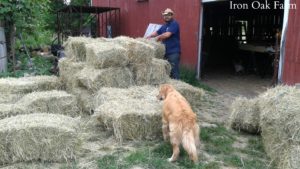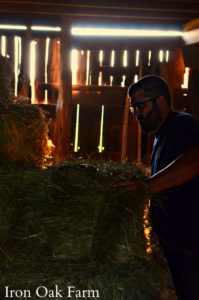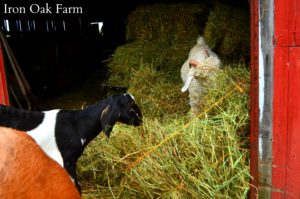Proper Storage of Hay and Pricing
Once you’ve collected a quality hay crop the hay must be stored properly. This is the final step in ensuring a good return at auction. Even the best hay, if improperly stored can ruin your efforts.
Storage
Proper storage of hay is extremely important.  Wet, tightly packed hay can begin to compost bringing temperatures up so high that it’s been known to catch fire. If your property doesn’t already have a barn large enough that can store hay, you will have to figure a structure into your cost.
Wet, tightly packed hay can begin to compost bringing temperatures up so high that it’s been known to catch fire. If your property doesn’t already have a barn large enough that can store hay, you will have to figure a structure into your cost.
Hay should only be baled if it is completely dry. Once bailed, the hay should not be allowed to get wet. Hay stored in a dirt floor building should be lifted up off the ground so ventilation can happen under the bales and so that moisture isn’t drawn up from the earth. Old pallets work well for this. We have a dirt floor barn and until we get a hay elevator to store it in the upper story, we stack our hay on 4×4 boards.
You don’t have to have a typical barn to store hay. Carport shelters, properly placed tarps and even semi truck trailers can be used to store hay.
Moldy hay will make animals sick, and will not bring a good price.
Round Bales vs. Square Bales
 Round Bales are just as they sound, round shaped bales around 5ft tall and weigh around 700 lbs. Round bales have advantages and disadvantages. They are usually more cost effective. You get more for your money with a round bale. They average in price in our area from $75 – $90. You can also store them outside as they are usually wrapped in plastic.
Round Bales are just as they sound, round shaped bales around 5ft tall and weigh around 700 lbs. Round bales have advantages and disadvantages. They are usually more cost effective. You get more for your money with a round bale. They average in price in our area from $75 – $90. You can also store them outside as they are usually wrapped in plastic.
However, the disadvantage is that you need heavy duty equipment to load, transport and to move them to the area where your animals are.
Small Square bales are easier for us, a small scale farm, because they can be moved by hand, are manageable and stackable. Also the production equipment is more affordable.
Pricing
 Hay can be expensive, and for good reason in my opinion. Anyone who complains about the price of hay should spend a summer making it and it may change their opinion. It’s hard, backbreaking work, hot, sticky and itchy. You have to be a weather psychic and be willing to accept that a surprise thunderstorm can ruin your crop and all your hard work. You have to be willing to put all projects on hold if it looks as though there might be a good stretch of weather. Many times we’ve cancelled plans with family and friends, rescheduled appointments and stopped projects in the middle of production to get the hay in.
Hay can be expensive, and for good reason in my opinion. Anyone who complains about the price of hay should spend a summer making it and it may change their opinion. It’s hard, backbreaking work, hot, sticky and itchy. You have to be a weather psychic and be willing to accept that a surprise thunderstorm can ruin your crop and all your hard work. You have to be willing to put all projects on hold if it looks as though there might be a good stretch of weather. Many times we’ve cancelled plans with family and friends, rescheduled appointments and stopped projects in the middle of production to get the hay in.
With hay you are paying/charging for the labor it takes to make hay. Losses from unpredictable weather are also factored into the cost of hay, as is the immediate pressure from the farmer to harvest when the hay is ready. Hay waits for no one. If you have a window of permittable weather you have to take advantage of it, no matter what other project may be pressing. The weather determines when hay is harvested not the farmer.
You are also paying for the condition of the crop which I covered in Part 2 of this series.
You can also factor in the growing conditions of the season.
Seasonal Growing Conditions
I recently posted a question to our social media audience and asked what was the average going rate for a bale of hay was in different areas of the country. I got a range of prices any where from $3 to $12 a bale with some extremely high examples in rare circumstances.
A few years ago I remember we had a drought, and the hay simply didn’t grow. It burned up and turned brown in the field. That year hay was going anywhere from $9 to $11 a bale. Farm stores were shipping hay in from other states. It was an expensive year.
The following year, we had so much rain that there was plenty of hay, but no dry times to cut. Hay was also expensive that year. It seemed that normal hay prices may never return.
The best guide in pricing and buying hay is knowledge. Know your field, know what your animals need, know what your customer is looking for. Go to hay auctions and compare your hay with similar harvests and prices.
How to Sell
 -Look for hay auctions in your area
-Look for hay auctions in your area
-Sell from your farm roadside
-Check “Hay Groups” on social media. These sites allow farmers to post hay harvests for sale and help potential buyers find hay farmers in their area.
-You can allow customers to collect the hay from the field themselves at a reduced rate.
-Contact farm stores in your area and ask if they are looking for a local farmer to supply hay.
Be sure to check out the other posts in this series:
A Guide to Buying and Selling Hay Part 1: Making Hay and Buying Equipment
A Guide to Buying and Selling Hay Part 2: Types of Hay and Determining Quality










